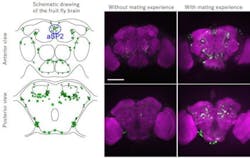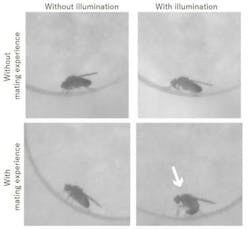Optogenetics helps analyze insect neural circuits for instinctive behaviors
To obtain full pictures of neural circuits and their functions responsible for innate behaviors, it is necessary to reveal neural circuits that are activated when an innate behavior takes place. A method is also required that can control insect behavior by manipulating activities of neural circuits in an artificial manner.
Recognizing this, a team of researchers at Kanazawa University (Kanazawa, Japan) has been using optogenetics (the use of light to control cells in living tissue) to study the functions of neural circuits, focusing on genes whose expression occurs in a neural activity-dependent manner. Previously, the group identified a transcription factor gene Hormone receptor 38 (Hr38) that is expressed in a neural activity-dependent manner in the insect brain and found that this gene is a useful marker for neural activities.
In the present study, the group used the fruit fly (Drosophila melanogaster) to generate a genetically modified strain that precisely reflects the expression pattern of Hr38, establishing a method that can specifically visualize active neurons by labeling them with green fluorescent protein (GFP). Using this method, they revealed a full picture of the male fruit fly's neural circuits in the brain and ventral nerve cord that were activated when a male fly interacted with a female fly. It is known that the sex-determining gene fruitless and doublesex determines the sex of neural systems in the brain and ventral nerve cord of the fruit fly, and that these genes are responsible for development of male- and female-type neural circuits. The group applied their method specifically to neural circuits that express fruitless or doublesex, revealing active neural circuits within the male-type neural circuits during the courtship behavior. As a result, the group found that neural cluster aSP2 was active specifically when a male fly interacted with a female fly, as well as the neural circuits already known to be important in regulating the mating behavior.
Schematic drawings of the fruit fly brain are shown (left). Neural cells, which express GFP upon mating behavior, are shown in green (upper drawing shows an anterior view, while the lower shows a posterior view). The right panels show pictures of the brains of male flies with or without mating experience. The entire brain is stained purple and the neural cells that were active during mating are stained green. Scale bar: 100 µm. (Image credit: Kanazawa University)
In addition to the visualization of neural circuits activated during a behavior, it is important to be able to manipulate neural circuit activity in a desired manner to reveal neural circuit functions. Therefore, the group generated a Drosophila strain that can activity-dependently express CsChrismon, a light-activated channelrhodopsin, in place of GFP. A male fly of this strain was allowed to experience mating with a female fly—on the following day, after removal of the female fly, the male fly alone was illuminated. The male fly, although in the absence of any female fly, showed abdominal bending typical of copulation behavior. This indicates that the neural circuits that were activated during the mating the previous day can be reactivated by light one day later.
Optogenetic reactivation of male fruit flies' neural circuits that express CsChrimson in an activity-dependent manner are shown. The male flies without mating experience did not show mating behavior upon illumination (upper photos), while the male flies with mating experience did show mating behavior, abdominal bending (indicated by an arrow), upon illumination. (Image credit: Kanazawa University)
Furthermore, the group analyzed the functions of the neural cluster aSP2 on mating behavior. Detailed analysis of courtship behavior of the male flies whose aSP2 neural activity was inhibited revealed that male flies approached female flies in a normal manner, but showed frequent interruption of courtship. As a result, mating success rate was reduced significantly. In the courtship of the fruit fly, the persistent dynamic approach of male flies to females, who may be reluctant at first, is important in the females' acceptance of mating. The present result shows that the neural cluster aSP2 plays an important role in regulation of motivation during courtship behavior.
Related: Optoacoustic imaging method can observe large neural circuits in 3D and real time
The present study has established methods to visualize neural circuits in an activity-dependent manner in insects and to manipulate their activity. These methods should be applicable to the elucidation of neural circuits and their functions in innate behaviors of insects. Understanding the neural basis of innate behaviors of insects is not only significant in fundamental science, but could contribute to applications such as the efficient utilization of beneficial insects like the honeybee and the silkworm, getting rid of noxious insects, and prevention of epidemics of diseases such as malaria, dengue fever, and Zika virus, all of which are mediated by the mosquito. This study identified the neural cluster aSP2 as an important neural circuit for motivation of an insect behavior.
It is expected that further research on the mechanism of how aSP2 neural circuit controls motivation will allow elucidation of fundamental regulatory mechanisms of innate behaviors in the insect brain.
Full details of the work appear in the Proceedings of the National Academy of Sciences.


